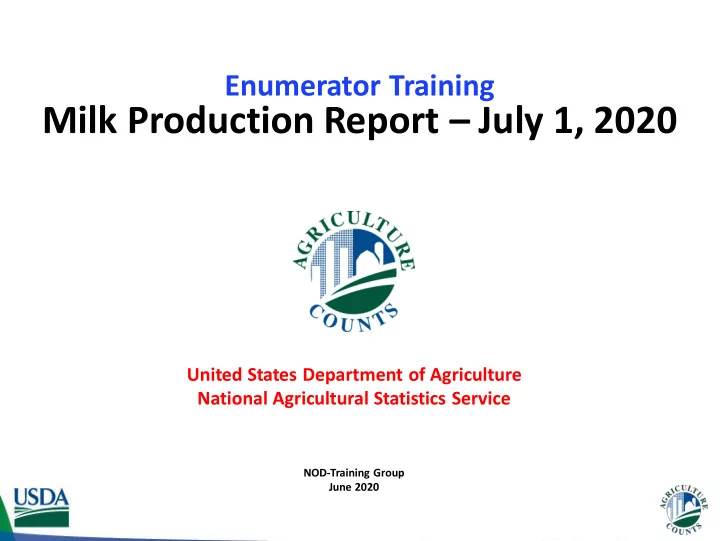

Enumerator Training Milk Production Report – July 1, 2020 United States Department of Agriculture National Agricultural Statistics Service NOD-Training Group June 2020
Collecting Information On : • July 1 st milk cow inventories and production • Local replacement milk cow prices • Baled hay purchased and price
Survey Information • Project Code: 178 - Milk Production Survey • Questionnaires: – Mailed June 22 nd – Web (EDR) reporting option available • Release: – Milk Production, July 21 st , 3:00 PM (ET)
Coding Inaccessible Records and Disconnected Phone #s • Do not code simple non-contacts such as No Answer or Answering Machine as “Inaccessible” • Inaccessibles must have a verified response before being coded as such (Hospital, Vacation, etc.) • Disconnected phone numbers should be coded in the address verification screen as “Disconnected” – Do not submit as Inaccessible – could still respond via internet
Who uses the data? • Producers can use the milk production information along with the milk cow inventory data to determine production and marketing strategies and plan purchases and capital investments for their operations. • Processors; warehouse, storage, transportation companies; and retailers rely on the reports to anticipate future volume. – How much milk is being produced? – Is there going to be enough milk to produce all of the products we have orders for?
Milk Production Report • July 1 st inventories and production – Total milk cows (include dry cows) – Cows milked – Milk produced • Total pounds or gallons, pounds or gallons per cow, other unit with description • Milk/cow averaged 66.4 pounds per day in April (U.S. avg.) – Indiana: 66.3 lbs./day – Michigan: 75.2 lbs./day – Ohio: 61.3 lbs./day
Milk Cow Prices • Price of milk cows for dairy herd replacement – Exclude heifers that have not calved • This is replacement price, NOT cull cow price • These would be cows that could be placed directly in the milking herd • Prices for registered herds may be much higher than for commercial herds • April U.S. average price for milk cows = $1,250 – Indiana: $1,220 – Michigan: $1,300 – Ohio: $1,170
Hay Prices Only in Select States • Baled hay purchased from other farmers during June AND amount paid – Alfalfa/alfalfa mixtures • Was any of the alfalfa you purchased premium or supreme grade? (Only asked in select states) – If so, how much and what was the cost? – Other hay (any other type of baled hay) CAPI asks for Total Tons of Hay purchased and Total Amount paid for the hay. If total bales and price per bale are reported you will need to use the calculator. Total Tons = Bales Weight Per Bale 2,000 pounds Total Amount Paid = Bales Price Per Bale
Average April Prices • Alfalfa, April 2020 – Michigan: $175.00/ton – Ohio: $200.00/ton • Other Hay, April 2020 – Michigan: $ 110.00/ton – Ohio: $140.00/ton 9
Things to Watch Out For • Large number of milk cows • High/low milk production per cow – Regardless of reporting units, calculated back to pounds per cow • High/low replacement cow price • High/low price per ton for hay
Things to remember • Short survey, but several possible ways to go wrong • USDA is providing direct support for farmers during the pandemic. FSA is administering the Coronavirus Food Assistance Program (CFAP) • Website: https://www.farmers.gov/cfap • No milk cows? • May very well still be in business with crops or other livestock. • IF out of business: • Ask questions and leave notes as to what happened with the operation • Record new operator information if possible
Conclusion • Looking at milk production and amount produced on July 1 st • Become familiar with specific includes and excludes • Be sure to leave notes explaining any unusual situations. • Comments, Concerns, Questions?
Recommend
More recommend